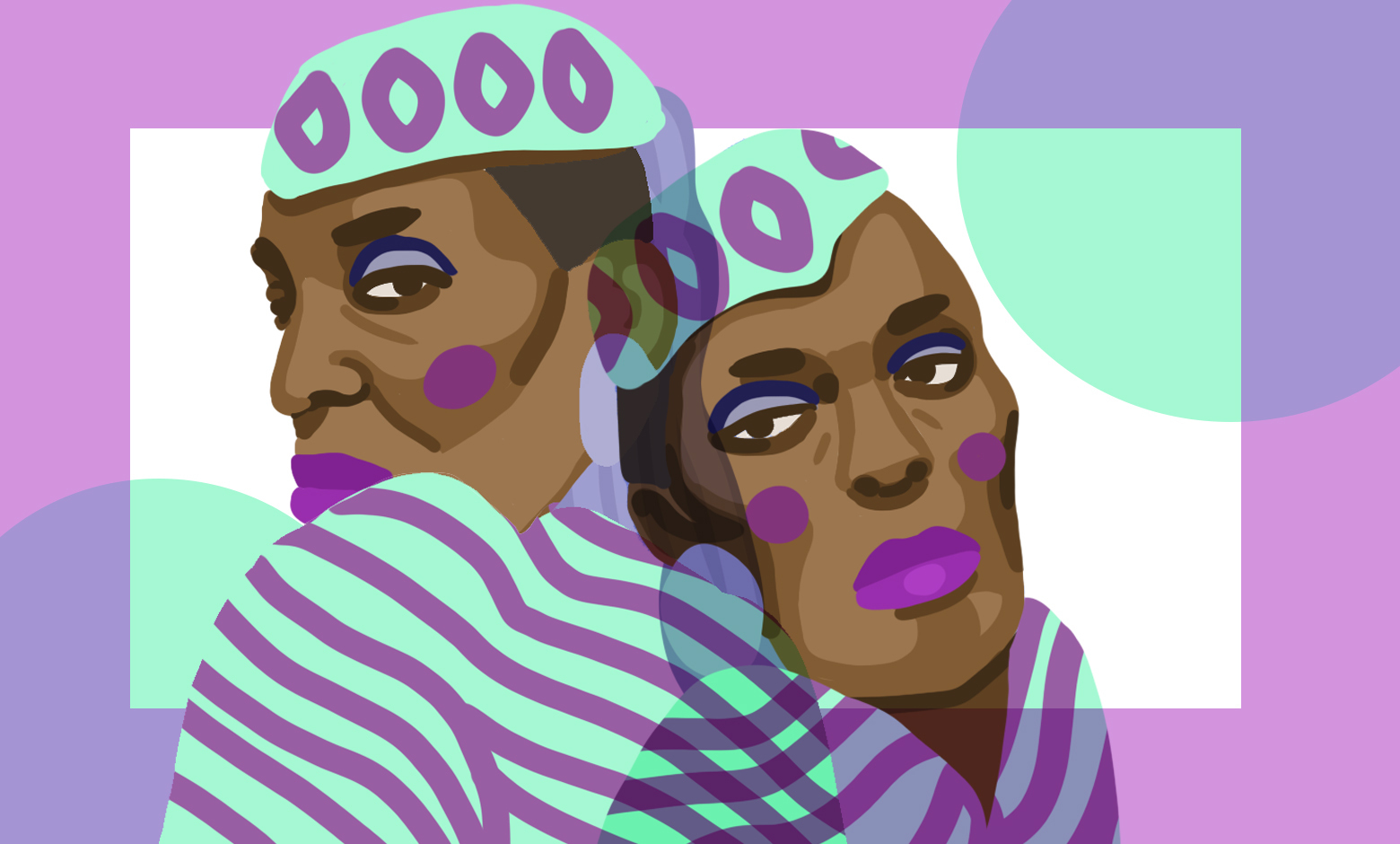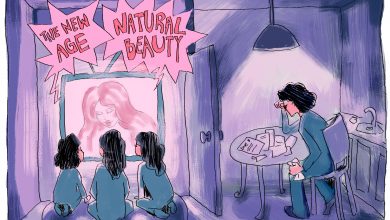Gender Fluidity in Fashion
The media’s emphasis on white cisgender men in the discourse of gender nonconformity

Design by Hailey Lynaugh
Image description: Two overlapping portraits of Black drag queen Pepper LaBeija. Pepper is wearing a matching mint green dress and hat with purple stripes. The background includes a purple border with green circles in two corners.
Vogue and mainstream media have centered the conversation on, and given praise to, a white man who people have assumed to be cisgender with the release of “Playtime with Harry Styles”cover’s a week before Transgender Day of Rememberance. Styles does not label himself and has openly supported LGBTQ rights, displaying pride flags at his own concerts. Being a cis woman, a large population within Harry’s fanbase, I have seen the media’s glorification of Harry Styles’ deviation from “masculine” style and how it has become a trend adopted by other white, cisgender men. Over the past few years, Styles’ fashion choices have been prominent in shaping his image. The artist’s collaboration with non-binary designer Harris Reed has greatly impacted his wardrobe, with glam-rock inspired ruffled blouses and high-waisted bell bottoms. Reed advocates for gender-fluid dressing and acknowledges the trans and gender-diverse voices within the fashion industry who have led the movement in reclaiming the garment narrative.
Following the rise of right-wing nationalism in the last decade, masculinity has been overemphasized in the quest for a successful and wealthy nation. Trump, along with other fascists, have emphasized masculine power through traditional patriarchal norms, while simultaneously using misogyny in the public sphere. This new wave of patriarchy and hypermasculinity have inevitably affected the public reception of Harry Styles’ cover.
Candace Owens, a Black pro-Trump conservative author and commentator, who openly criticized people’s movements such as Black Lives Matter and #MeToo, set the tone for the right’s reception towards Style’s cover. Following the release of Styles’ cover, Owens tweeted about the “steady feminization” of men and urges society to “Bring back manly men.” Further on in her tweet, Candace Owens distinguishes the West from the East, perpetuating the impact of Orientalism and its portrait of men. Manliness and strength have been constructed by Western systems of power. Through colonialism, cisgender white men developed the distinction between “the West and the Rest” in order to promote white supremacy and Western civilization. Imperialist violence, in conjunction with the patriarchy, continue to other communities of color, uphold the gender binary, and enforce normative masculinity. In doing so, the harmful systems maintain whiteness and cisgenderness as the ideal in defining a man. In line with this sentiment, Owens and other conservative voices make the assumption that society would function differently without “strong men.” However, these characteristics should not be confined to a narrow set of qualities assigned to one gender, when gender itself is a spectrum. The public attraction to an image of a cisgender man’s strength is prioritized over gender non-conforming identities.
With the heightened discourse of identity politics following the rise of cancel culture, individuals from the left and the right expressed criticism over Styles’ cover. In addressing the scandals of public figures, the attention and blame are placed on the individual, rather than the real issues, which reside within systems of power. In this case, the focus of the media and public critique is on Harry Styles, but Western media, racism, and heteronormativity are responsible for the exclusion of non-binary and trans people of color within larger creative spaces.
Vogue and the fashion industry as a whole are also accountable for the lack of gender non-conforming voices. In 2017, Vogue depicted Zayn Malik and Gigi Hadid as “gender fluid,” when neither of the two identify as such. The original headline read: “Gigi Hadid and Zayn Malik Are Part of a New Generation Embracing Gender Fluidity.” The sentence presents how publications favor cisgenderness and heteronormative relationships. By placing Malik and Hadid as faces of the gender fluid movement, Vogue embraces the minimal standards set for cisgender celebrities in deviating from gendered fashion. The couple’s 2017 cover and Harry Styles’ cover both display how the media disregards the trands, non-binary, and gender non-conforming activists, organizers, and artists leading the movement.
Other, non-American, Vogue publications have previously featured trans and gender non-conforming creatives. For example, British Vogue featured Laverne Cox, a Black trans actress on its cover in August 2019. In Latin America, Pabllo Vittar and Gloria Groove were the first drag queens to make the cover of Vogue Brasil earlier this year. These achievements reveal the focus of American media on white and cis bodies, not giving the same recognition to queer people of color.
Fenella Hitchcock, a lecturer at London College of Fashion states, “It’s an issue in terms of who gets to have these transgressive moments. We have cis white men who are celebrated for doing the very things that queer people do in day-to-day life all the time.” Considering the fashion industry’s cyclical use and profit off of the gender binary, shifts in the normative forms of masculinity stand out to the global public, illustrating specific acts as “revolutionary.” As seen through the TikTok phenomenon of “fem boy” culture and the rise in popularity of “feminine” men such as Timothee Chalamet, mainstream culture has embraced and employed aesthetics which challenge the gender binary on white cisgender men for capitalist gain. The dialogue evokes how cisgender men can utilize femininity as a form of self-expression, while women’s femininity remains tied to male pleasure and attraction. The systemic discrimination is compounded even within trans and genderqueer communities, as white, cisgender, and male figures are still held up as the ideal, highlighting the role of transmisogyny.
Gender non-conforming author and artist Alok Vaid-Menon discusses the trans femmes of color who began the gender fluid movement in fashion and explains how non-white and non-cis bodies are not accepted within white and heteronormative platforms. By using Styles, Vogue capitalizes on his whiteness and heteronormativity, while ignoring the identities and experiences of BIPOC trans and non-binary folks. Western publications and media outlets lack queer creatives of color, especially Black trans individuals in the discourse of representation within media. In erasing real and lived experiences, the media plays into the complicity of heteronormative society in the enforcement of the gender binary, which further represses individuality and creative expression.
There are histories of oppression through the colonized Western system of the gender binary. During the 19th century, the British detained any individual in India whom they read as a man wearing “feminine” clothing. Indian eunuchs were marginalized and culturally erased through the imperialist authorities and regulation. Clothing as a tool of resistance has roots within colonial legacies and communities of color. The white enforcement of the gender binary further oppresses Brown non-conforming people, presenting the complex and layered intersection of race and gender. In the United States, NYPD strip searched gender non-conforming people under the Three Article/Piece Law. The informal law required individuals to wear at least three articles of clothing which were assigned to their gender from the 1940s to the 1960s. Through this law and other masquerade laws, police specifically targeted low income, Black trans and non-binary individuals. The cross-dressing laws were built upon the cis heteronormative restriction of movement by genderqueer people. In implementing such regulations, the American police state upheld the exclusion of queer and non-binary folks. The discrimination from the police and other heteronormative systems faced by the LGBTQ community led to protests in the streets with the Stonewall uprising in 1969.
Harassment and assault on the bodily autonomy of trans and non-binary communities continue to exist and persist over 50 years after the Stonewall riots. In Alok Vaid-Menon’s talk “Clothes Have No Gender,” they describe their own experiences and the history of Black trans folks in liberation and gender expression. When trans and non-binary people of color exhibit actions which deviate from their socially designated and assigned gender, the media uses their bodies for entertainment rather than education, often excusing the action as a costume or temporary issue rather than part of one’s identity. Conversely, cis white folks who don’t conform to gender expectations are accepted and highlighted by the media as avant-garde pioneers in shifting gender norms, taking credit for movements built by gender non-conforming people of color. It is unacceptable that publications have chosen to only celebrate cisgender heterosexual men at the forefront of gender neutral fashion and “new masculinity.” They stress how gender fluidity cannot be a fashion trend, when it is rooted in a people’s movement led by trans activists.
Furthermore, the dismantling of toxic masculinity requires much more than men wearing dresses and skirts. Patriarchy runs deeper than individual style choices, as it’s rooted within everyday choices and ways of living. If we want to make societal changes in gender discrimination, we must address the systemic flaws and inequalities which have continued to exclude specific communities. There is certainly never as much praise given to women, trans, and non-binary people who also deviate from the heteronormative standards, either through clothes or other forms of self-expression. Although we are beginning to see more individuals comfortable in challenging the gender binary, we must do more in advocating for Black and trans liberation. Black trans people have led and continue to lead the LGBTQ+ civil rights movement and gender non-conforming fashion.
While society can celebrate Styles’ cover, we must simultaneously acknowledge the trans people of color who made the cover possible, after decades of cross-dressing legislation. Gender fluidity in fashion has created more expansive images of femininity, masculinity, and beauty; yet, it has failed to include BIPOC trans and gender non-conforming artists. Media must do better in hiring trans and non-binary creatives and amplifying their ideas, rather than just valuing their aesthetics. We must aid and recognize the organizations fighting for trans justice in combating local and global transphobia. While forms of expression as political acts and becoming more open about identity is vital, there are other issues attributed to patriarchy that are often ignored. The most pressing issues are ones that people have yet to confront and (un)learn. The current mainstream institutions and industries have created regressive gender stereotypes and violence, which is experienced by genderqueer people on a daily basis. There needs to be a more holistic discussion of the politics of representation in the fight for inclusivity and liberation.




